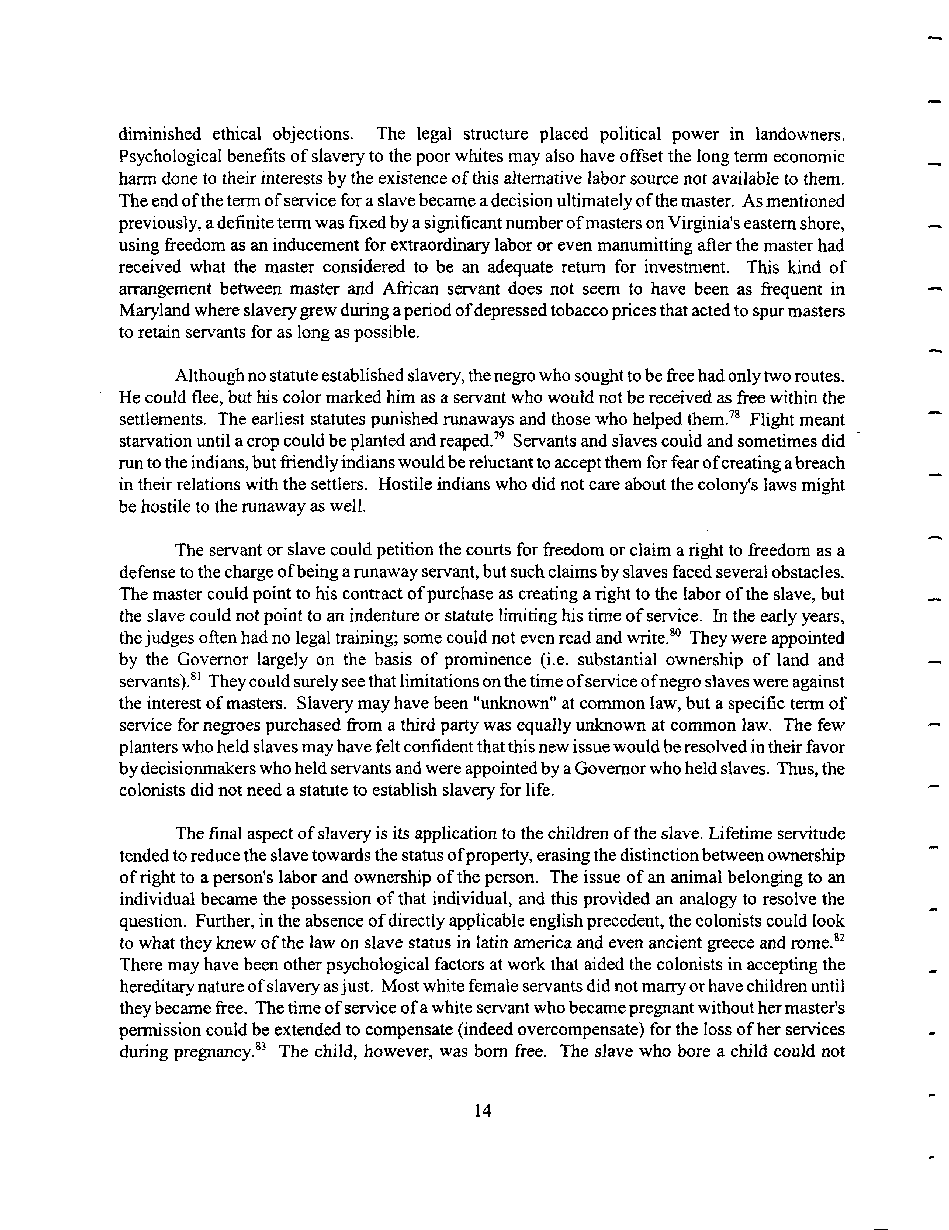|
diminished ethical objections. The legal structure placed political power in landowners.
Psychological benefits of slavery to the poor whites may also have offset the long term economic
harm done to their interests by the existence of this alternative labor source not available to them.
The end of the term of service for a slave became a decision ultimately of the master. As mentioned
previously, a definite term was fixed by a significant number of masters on Virginia's eastern shore,
using freedom as an inducement for extraordinary labor or even manumitting after the master had
received what the master considered to be an adequate return for investment. This kind of
arrangement between master and African servant does not seem to have been as frequent in
Maryland where slavery grew during a period of depressed tobacco prices that acted to spur masters
to retain servants for as long as possible.
Although no statute established slavery, the negro who sought to be free had only two routes.
He could flee, but his color marked him as a servant who would not be received as free within the
settlements. The earliest statutes punished runaways and those who helped them.78 Flight meant
starvation until a crop could be planted and reaped.79 Servants and slaves could and sometimes did
run to the indians, but friendly indians would be reluctant to accept them for fear of creating a breach
in their relations with the settlers. Hostile indians who did not care about the colony's laws might
be hostile to the runaway as well.
The servant or slave could petition the courts for freedom or claim a right to freedom as a
defense to the charge of being a runaway servant, but such claims by slaves faced several obstacles.
The master could point to his contract of purchase as creating a right to the labor of the slave, but
the slave could not point to an indenture or statute limiting his time of service. In the early years,
the judges often had no legal training; some could not even read and write.80 They were appointed
by the Governor largely on the basis of prominence (i.e. substantial ownership of land and
servants).81 They could surely see that limitations on the time of service of negro slaves were against
the interest of masters. Slavery may have been "unknown" at common law, but a specific term of
service for negroes purchased from a third party was equally unknown at common law. The few
planters who held slaves may have felt confident that this new issue would be resolved in their favor
by decisionmakers who held servants and were appointed by a Governor who held slaves. Thus, the
colonists did not need a statute to establish slavery for life.
The final aspect of slavery is its application to the children of the slave. Lifetime servitude
tended to reduce the slave towards the status of property, erasing the distinction between ownership
of right to a person's labor and ownership of the person. The issue of an animal belonging to an
individual became the possession of that individual, and this provided an analogy to resolve the
question. Further, in the absence of directly applicable english precedent, the colonists could look
to what they knew of the law on slave status in latin america and even ancient greece and rome.82
There may have been other psychological factors at work that aided the colonists in accepting the
hereditary nature of slavery as just. Most white female servants did not marry or have children until
they became free. The time of service of a white servant who became pregnant without her master's
permission could be extended to compensate (indeed overcompensate) for the loss of her services
during pregnancy.83 The child, however, was born free. The slave who bore a child could not
14
�
|

